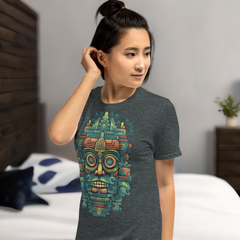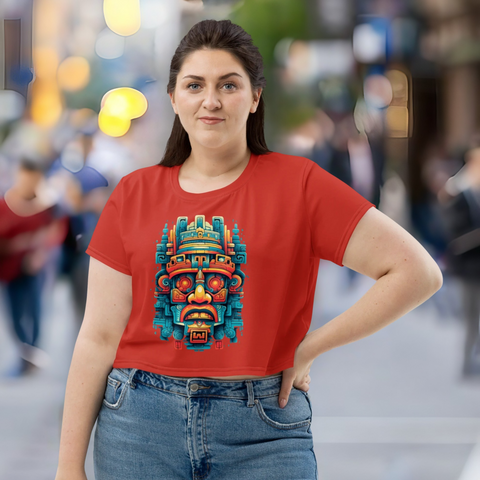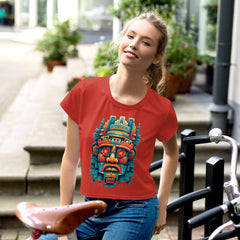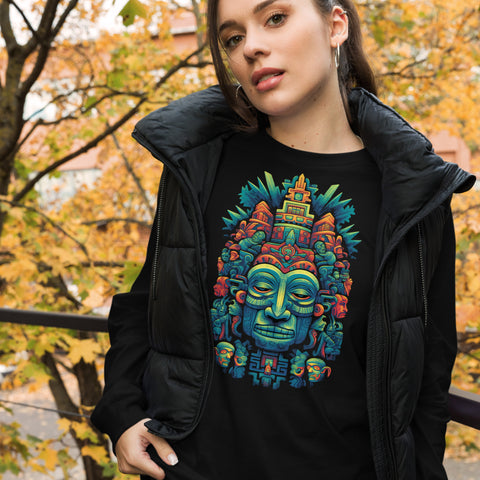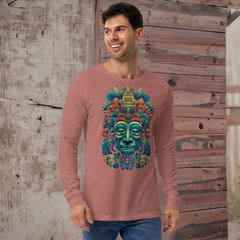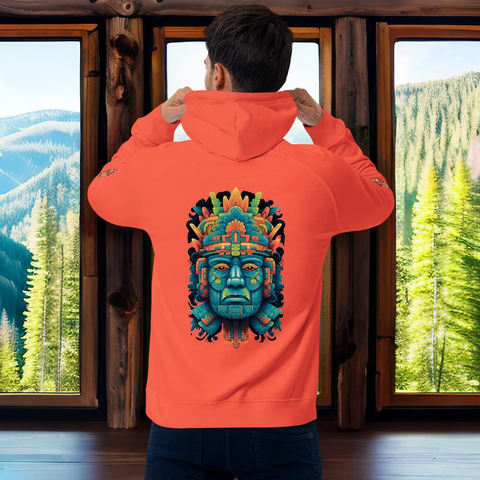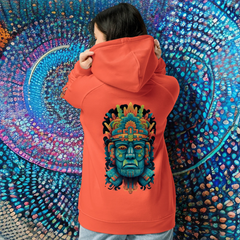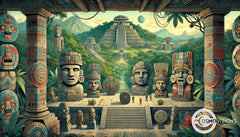Unveiling the Mysteries of Olmec Religion in the Ancient Civilization
Posted by Massimiliano Geraci

Exploring the religious beliefs of an ancient civilization can be a fascinating journey. It opens a gateway to understanding the cultural foundations that shaped societies and influenced subsequent generations.
One captivating example is the Olmec civilization, which thrived in ancient Mexico during Pre-Classical Mesoamerica from c. 1200 BCE to c. 400 BCE. Considered the “mother culture” of ancient Mesoamerica, the Olmecs' influence and trade activity spread from the Gulf of Mexico to present-day Nicaragua, with their heartlands in the states of Veracruz and Tabasco.
Their enigmatic religious practices left an indelible mark on the region’s spiritual landscape. This article delves into the mysteries surrounding the Olmec pantheon, rituals, and supernatural entities, offering insights into their profound impact on later Mesoamerican cultures.
Unveil the secrets of a civilization that laid the cornerstone for religious traditions that still resonate today.
Key Takeaways
1. The Olmec civilization had an intricate pantheon of deities, including the Olmec Dragon (God I), representing fertility and creation, the Maize Deity (God II) symbolizing agricultural abundance, the Rain Spirit and Were-jaguar (God III), embodying the forces of rain and primal power, the Banded-eye God (God IV) representing revered rulers or ancestors, and the Feathered Serpent (God V) symbolizing the connection between earthly and celestial realms.
2. Olmec rituals and ceremonies involved sacrificial offerings, such as bloodletting, human sacrifice, and offerings of prized items like jade, animals, and crops like maize. Cave rituals and pilgrimages to sacred sites were integral aspects of their religious observances, involving shamanic rituals, offerings, and symbolic metaphysical journeys.
3. The Olmec revered a supernatural entity called the Fish or Shark Monster (God VI), believed to be the ruler of marine realms and symbolizing their intimate relationship with coastal ecosystems. The Olmec religion's influence extended to later Mesoamerican cultures, shaping their deities, symbols, and religious practices.
4. The Olmec gods often manifested zoomorphic or anthropomorphic traits, reflecting their profound connection to nature and the cosmos. Recurring motifs across Olmec iconography, such as the Feathered Serpent, Rain Spirit, and Were-Jaguar, reflected their complex belief system and religiosity permeating all aspects of their civilization.
5. The Olmec religion emphasized nature's power through cave rituals, maize worship, and veneration of deities like the Maize Deity and Rain Spirit. Their spirituality laid the foundations for future Mesoamerican societies, influencing cultures for centuries through their gods, rituals, and symbolic representations.
Key Deities of the Olmec Pantheon
The Olmec pantheon contained many deities. As the first Mesoamerican civilization, the Olmec culture had a significant influence on the social development and mythological worldview of Mesoamerica. Their gods were intertwined with nature, agriculture, and cosmic forces.
Scholars believe the Olmec Dragon represented fertility and creation. This supernatural reptilian figure is one of the most iconic Olmec artworks. Carved stone monuments depict the entity presiding over scenes of sacrifice and ritual.
The Olmec Dragon (God I)
The Olmec Dragon, also called the Earth Monster, embodied a powerful entity. Olmec art depicts it with flame eyebrows, a bulbous nose, and a bifurcated tongue - symbols of its formidable presence.
As an apex supernatural being, the Olmec Dragon likely represented nature’s raw forces and the primordial creative energy that birthed the cosmos.
Archaeologists uncover iconography of this deity across major sites like San Lorenzo and La Venta. Its prevalence suggests the Olmec Dragon held immense spiritual significance, perhaps personifying the earth’s fertility and agricultural cycles so vital to early Mesoamerican civilizations.

The Maize Deity (God II)
Unlike the imposing Olmec Dragon, God II symbolized sustenance and agricultural abundance. We transition to the vibrant Maize Deity – sprouts bursting from its iconic cleft head.
This life-giver represented maize cultivation, a foundation of Olmec society.
The Olmecs revered maize as sacred, its nutritious kernels fueling their civilization. God II embodied this vital crop's significance – carvings depict the deity with maize plants emerging from its head.
Such iconography immortalizes maize's centrality to Olmec existence and belief systems. Rituals honoring this deity likely ensured bountiful harvests, confirming maize's spiritual and practical value.
The Rain Spirit and Were-jaguar (God III)
Moving beyond the Maize Deity, we encounter the enigmatic Rain Spirit and Were-jaguar (God III). These entities embody the life-giving forces of rain and the primal power of the jaguar.
Representations depict a supernatural being with feline attributes, suggesting a deep reverence for nature's cycles. Scholars debate whether they constitute one or two distinct deities.
However, their symbolism underscores the Olmec's profound connection to the environment. Offerings and rituals likely sought to appease these forces, ensuring bountiful harvests and protection.
Carved figurines and monumental sculptures provide insights into this revered supernatural. Jaguar motifs frequently appear, highlighting the creature's importance in Olmec cosmology.
Ceremonies may have involved transformative jaguar rituals, in which shamans embodied the animal's spirit. This duality reflects the Olmec's intricate belief system, which intertwined human and animal realms.
The Banded-eye God (God IV)
The Banded-Eye God, or God IV, stood out among the Olmec pantheon. Its carved stone sculptures featured a distinct narrow band across the face—an iconic identifier. Art historians believe this deity represented a revered ruler or ancestor figure.
The mesmerizing gaze of the Banded-eye God suggests an otherworldly presence watching over the Olmec people. - Dr. Rebecca Gonzalez, Mesoamerican Art Specialist
Colossal basalt heads depict God IV wearing an elaborate headgear and displaying individualized facial features. These life-size portraits symbolized the power and prestige of Olmec rulers.
The Feathered Serpent (God V)
The Feathered Serpent, a revered deity in the Olmec pantheon, symbolized the intricate connection between the earthly and celestial realms. This enigmatic figure, adorned with serpentine and avian attributes, embodied the profound reverence the Olmecs held for nature's cycles.
Its undulating form graced numerous artifacts, suggesting a pivotal role in rituals and ceremonies.
Scholars theorize the Feathered Serpent may have originated as an amalgamation of earlier Mesoamerican myths. Its significance transcended mere representation, encapsulating the Olmecs' understanding of the cosmos's complexities.
Rituals and Ceremonies
Ceremonies marked pivotal events in Olmec culture. Ritual spaces hosted sacrifices to appease supernatural forces.
Shamans conducted cave rituals, venerating earth's womb. Pilgrimages to sacred sites solidified communal identity. The Olmec offered maize, jade, and blood to deities and ancestors.

Sacrifice and Offerings
Olmec rituals involved sacrificial offerings. Bloodletting ceremonies occurred.
1. Stingray spines indicate sacrificial bloodletting practices.
2. Artifacts suggest human sacrifice took place.
3. Sacrifices aimed to please deities.
4. Offerings included prized items like jade.
5. Animal sacrifices of jaguars and birds occurred.
6. Maize and other crops were likely offered.
7. High-status individuals led sacrificial rites.
8. Blood offerings represented life renewal.
9. Sacrifices maintained cosmic order and balance.
10.Rituals occurred at major centers like San Lorenzo.
Cave Rituals and Pilgrimages
1. Caves held immense spiritual significance for the ancient Olmec civilization.These subterranean sanctuaries served as sacred gateways to the supernatural realm.
2. Pilgrimages to hallowed cave sites formed an integral aspect of Olmec religious observances.
3. Ritual ceremonies occurred within the cavernous depths, performed by shamans and high priests.
4. Offerings like jade, obsidian blades, copal incense, and sacrificed humans/animals propitiated deities.
5. The act of traversing treacherous underground passages symbolized a metaphysical journey.
6. Stalagmites and stalactites evoked phallic and fertile imagery connected to agricultural fertility rites.
7. Wall etchings depict shamanic rituals involving entheogenic substances derived from fungi and plants.
8. Certain caves like Gálvez functioned as pilgrimage destinations where the faithful converged.
9. Shrines established at cave entrances received devotional offerings from traveling pilgrims.
10. Archaeological finds hint that some caves served as interment sites for elite individuals.
11. The echoing acoustics inside enhanced trance experiences and spirit communication rituals.
12. Visiting caves allowed the living to commune with ancestral realms and deified nature forces.
Olmec Supernaturals and their Significance
Olmec supernaturals reveal the spiritual undercurrents of a profound civilization. These divine representations transcended the earthly realm and embodied nature's potent forces.
Fish or shark monsters symbolized the sacred waters that nourished life. Their presence illuminates Olmec reverence for aquatic realms, which are tributaries to mythic origins.

Fish or Shark Monster (God VI)
The Olmec revered a supernatural entity – the Fish or Shark Monster (God VI). This being possessed distinctive features like shark teeth, a crescent-shaped eye, and a small lower jaw.
Olmec artisans sculpted an anthropomorphic Fish Monster displaying crossed bands, a dorsal fin, and a split tail. Archaeologists interpret these figures as representations of a powerful ocean deity in the Olmec pantheon.
The Olmec civilization thrived near the Gulf coast. They likely conceived the Fish Monster as a ruler of marine realms. This god may have held symbolic links to navigational knowledge, fishing rites, or maritime trade networks.
The crossed bands evoke serpentine or shark-like qualities – iconography common in Mesoamerican symbolism. Scholars theorize that veneration of this aquatic supernatural transcended mere religious beliefs.
Continuity and Influence on Later Mesoamerican Cultures
Venturing beyond the fish or shark monster, scholars trace Olmec influence in subsequent Mesoamerican faiths, noting how Olmec culture and trade activities spread to other Mesoamerican regions, reaching as far as present-day Nicaragua. Miguel Covarrubias championed this idea in 1957—suggesting Olmec deities birthed 19 rain gods of later civilizations.
Marshall Howard Saville aired similar views in 1929. Like colossal heads, Olmec carvings reveal precursors of Maya, Aztec, and other iconic figures. The feathered serpent, banded-eye deity, and dragon-like beings carried symbolism forward.
This continuity binds the first Mexican culture to its successors, illuminating ancient Mesoamerican thought.
Deep Dive into Olmec Gods and Supernaturals
The Olmecs venerated a complex pantheon. Key figures included the Olmec Dragon, the Maize Deity, and the Banded-Eye God. The Fish or Shark Monster exemplified their reverence for aquatic creatures.
This supernatural embodied the life-giving waters and represented fertility.
Many Olmec gods manifested zoomorphic or anthropomorphic traits. For instance, the Rain Spirit and Were-Jaguar fused human and feline elements. This deity exemplified the interconnectedness between humans, nature, and the cosmos.
The Feathered Serpent symbolized agricultural cycles and rebirth. Recurring motifs across Olmec iconography reflected profound religiosity pervading all aspects of civilization.
Conclusion: The Impact of Olmec Religion on Mesoamerican Civilization
The Olmec religion shaped civilizations across Mesoamerica. Its gods and rituals influenced cultures for centuries. The Feathered Serpent and rain deities became pivotal symbols. San Lorenzo's colossal heads reflect reverence for rulers.
Olmec spirituality emphasized nature's power through cave rituals and maize worship. This mother culture laid foundations future societies built upon.
FAQs
1. What were the gods of the Olmec civilization?
The Olmec, the first major Mesoamerican civilization in present-day Mexico, worshipped eight principal deities -- including the maize god and rain deities. These gods played a central role in their religious practices and belief systems.
2. Why are the Olmec colossal heads significant?
The colossal stone heads found at major Olmec sites like San Lorenzo and La Venta are thought to depict individual Olmec rulers or important figures. These massive sculptures provide insights into the Olmec culture's artistic achievements and religious iconography.
3. How did the environment shape Olmec religion?
The Olmec heartland, spanning the states of Veracruz and Tabasco, profoundly influenced their spiritual beliefs. For instance, they likely grew crops like maize and medicinal herbs -- activities deeply tied to their reverence for agricultural and nature deities.
4. What role did religion play in Olmec society?
Religion permeated all aspects of Olmec life, from ceremonial practices to artistic expressions. Religious activities and beliefs governed how this early civilization functioned and interacted with the world around it.
5. How do archaeologists study Olmec religion today?
Olmec artifacts, sites, and the colossal heads offer vital clues that help reconstruct their complex religious traditions. Scholars analyze these remains to decipher symbols, rituals, and the pantheon of deities central to this ancient culture.
Conclusion:
The Impact of Olmec Religion on Mesoamerican Civilization - The Olmec's sophisticated religious system, with its nature worship and monumental art, laid the foundations for many later Mesoamerican civilizations. Their spiritual legacy profoundly shaped the region's cultural and religious development for centuries to come.






